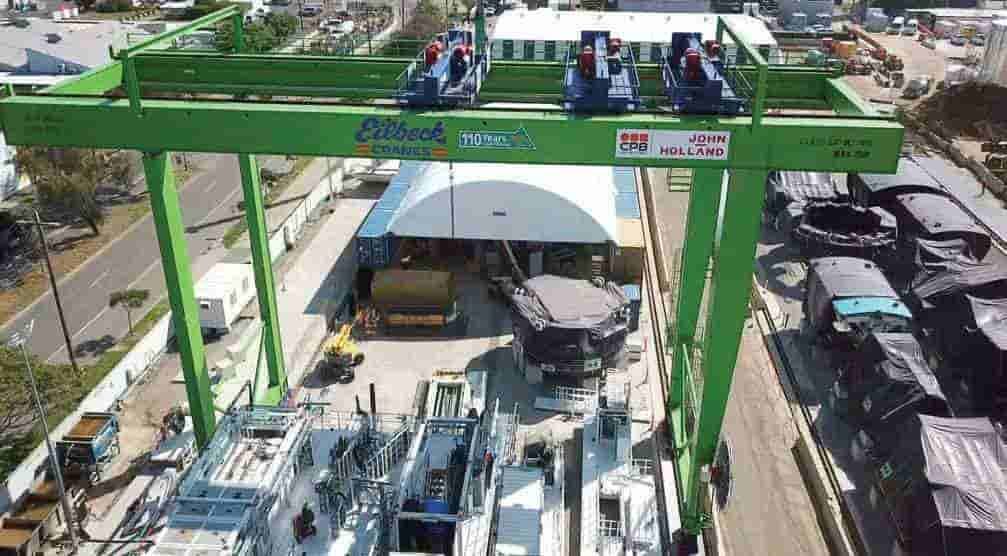Australian construction company purchases 260-ton overhead crane for tunnel project
To ensure the safe and stable advancement of tunnel projects, crane equipment is indispensable. Dongqi Crane recently noticed that an Australian construction services company is re-commissioning a 260-ton overhead crane for use in a tunnel project in the suburbs of Brisbane. We noticed that this crane was purchased in 2006 and was originally used for the assembly of tunnel boring machines in a tunnel in Brisbane. At the end of the project, the tunnel boring machine was dismantled and subsequently mothballed.
Dongqi Crane has some project experience in the role of crane equipment in tunnel projects. After seeing this news, I would like to summarize some experiences and provide a detailed analysis for those who want to know about tunnel projects and overhead cranes.
For this 260-ton bridge crane in the project, Dongqi Crane can infer some design details based on its work content:
- High lifting capacity: The 260-ton lifting capacity ensures that it can easily handle various large components of the tunnel boring machine.
- Stability and safety: Overhead cranes usually have a solid structure and stable supports to ensure stability during lifting and moving. In addition, safety mechanisms such as overload protection and anti-collision systems will also be equipped to prevent accidents.
- Operational flexibility: Cranes may have multiple operating modes to accommodate different assembly needs. The operator can precisely control the crane’s movements through the control system to accurately place components into predetermined locations.
- Adaptability: This type of crane may have the ability to adapt to different work environments, including indoor and outdoor environments, as well as tight spaces or irregular terrain that may be present.
- Easy maintenance: Good maintenance and upkeep are key to ensuring long-term and stable operation of the crane. Such cranes may be designed to be easy to service and maintain to reduce downtime and increase productivity.
- Please note that specific designs and features will vary based on manufacturer and usage requirements. When using this kind of crane, relevant safety regulations and operating procedures must be followed to ensure personnel safety and stable operation of equipment.

Introduction to the use of bridge cranes in tunnel projects
Overhead cranes play a vital role in tunnel projects. Its main uses include but are not limited to the following aspects:
- Lifting and installing beam sections, box culverts, bridge decks, tunnel segments, etc.: Bridge cranes have strong lifting capacity and operational flexibility, and can accurately lift and install these large components to ensure the stability and safety of the tunnel structure.
- Auxiliary construction operations: During tunnel construction, bridge cranes can assist workers in various operations, such as carrying construction materials, equipment or tools, thereby reducing workers’ labor intensity and improving construction efficiency.
- Providing temporary supports and platforms: In some complex tunnel construction environments, bridge cranes can build temporary supports and platforms to provide workers with a safe working space and ensure the smooth progress of the construction process.
In addition, overhead cranes can be modified and configured according to the specific needs of tunnel projects to meet the requirements of different tasks. For example, specific spreaders and clamps can be equipped to accommodate the lifting of components of different shapes and sizes, or sensors and monitoring systems can be installed to improve the accuracy and safety of lifting operations.
What types of cranes are needed for tunnel projects?
In a tunnel project, several types of cranes may be used, each with a different role. Here are some common crane types and their uses in tunnel projects:
- Bridge crane: Bridge cranes are mainly used in tunnel projects to hoist and install large components, such as beam sections, box culverts, bridge decks and tunnel segments. They usually have strong lifting capacity and high-precision operation performance to ensure accurate installation of components.
- Gantry crane (mobile gantry crane): Gantry crane is often used in tunnel construction and track laying and other tasks. They have large lateral dimensions and stability, are capable of full rotation, and are suitable for lifting and handling work in narrow spaces.
- Truck crane: Truck crane has the characteristics of strong maneuverability and high traveling speed, and can be quickly transferred to different working locations. In tunnel projects, they can be used to lift equipment, materials and components, especially in scenarios where quick response and flexible adjustments are required.
- Crawler crane: Crawler crane has excellent off-road performance and strong handling capacity, and is suitable for construction work in complex terrain conditions. In tunnel projects, they can be used to carry heavy loads, perform earthmoving operations, and assist other construction machinery.
- In addition, for the installation of tunnel arches, a tunnel arch crane may be used. This kind of crane adopts a double-arm structure, has the characteristics of automatic horizontal correction and stable rotation, and is suitable for the construction of tunnels with various arcs and sizes. It can accurately hoist and position tunnel arches to ensure the stability and safety of the tunnel structure.
Each crane type has its unique advantages and applicable scenarios. When selecting for use, it needs to be comprehensively considered based on the specific needs, working environment and safety requirements of the tunnel project. At the same time, ensure that the opera
